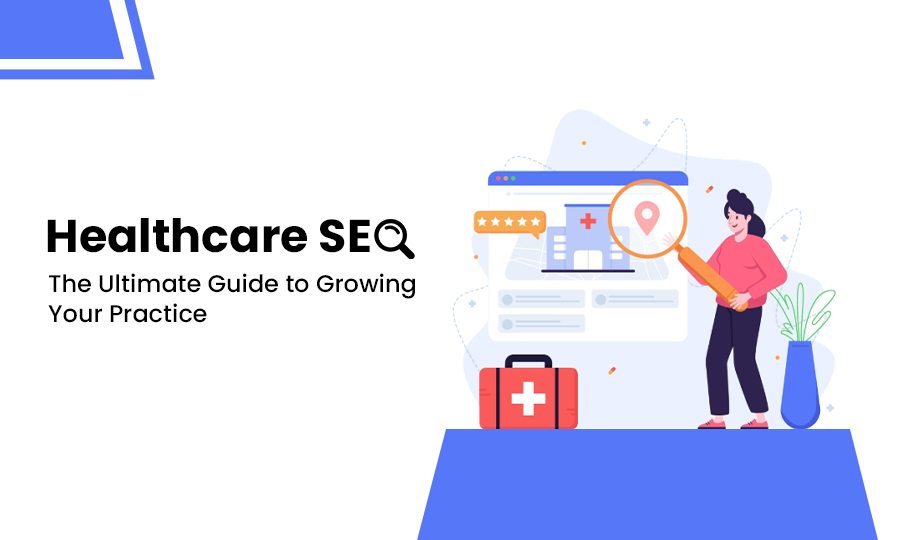In the past ten years, the health industry has undergone a tremendous change. Today, patients no longer rely on word of mouth or doctor referrals as they used to be the case in the past. They go on the internet and search for the best healthcare expert for their needs. Research shows that 77% of patients look on the internet before booking an appointment. So, whether a patient is researching symptoms, reading reviews, or looking for nearby clinics, being more visible is the key to connecting with patients if you are a healthcare professional. This is where Healthcare SEO comes in.
So, healthcare SEO is not merely a buzzword but a must-have strategy for any medical practice that wants to grow and thrive in this digital-first world. However, healthcare SEO requires extra care because it is about people’s health, trust, and the census guide is all about what healthcare SEO really means, why it matters, and practical steps to transform your online presence and attract more patients.
What is Healthcare SEO?
Healthcare SEO is the process of optimizing the online presence of your medical practice so patients can find your health facility when they search for healthcare services. It includes –
- Targeting the keywords patients use to book appointments.
- Optimising websites for speed, security, and user experience.
- Building credibility through content, reviews, and authoritative backlinks.
What makes healthcare SEO different is the industry. Unlike other businesses, medical practices deal with people’s health, so accuracy, compliance, and trust are key. For example, Google rates health-related content through its E-E-A-T framework (Experience, Expertise, Authoritativeness, and Trustworthiness).
Why SEO is Crucial for Healthcare Practices
When it comes to healthcare SEO, people think more about it in terms of business, improving online presence, or staying ahead of competitors. A good SEO will help in the growth of business for sure, but it is more than that. Healthcare SEO is also about building your trust and credibility with visitors who, in turn, can convert your clients. People will visit your website, they will find the services or treatment they are searching for, and will book an appointment only if it seems credible to them.
Easily navigable pages and treatment options are just one part of SEO. There will be reviews and testimonials left by satisfied patients, which will prompt new visitors to have treatment at your healthcare facility.
So, trust and credibility are the factors that make Healthcare SEO crucial for you.
Core Components of an Effective Healthcare SEO
Let’s deep dive into effective health SEO strategies to boost your website traffic and lead conversion.
1. Patient Journey Mapping & SEO
Understanding the patient journey — from symptom awareness to booking an appointment — helps you design content that meets their needs at each stage.
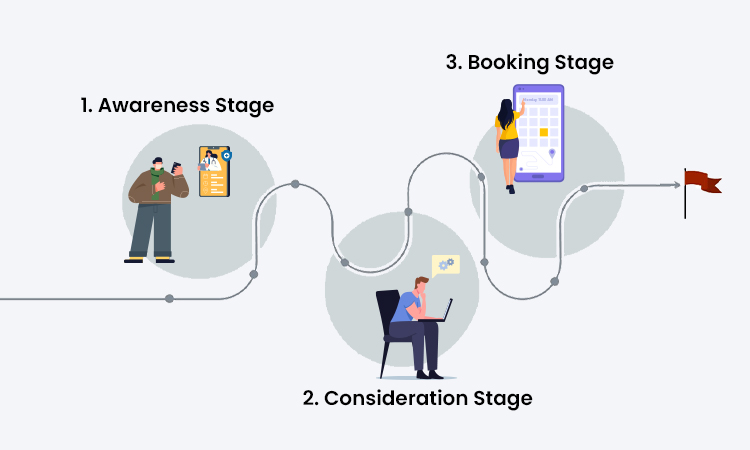
Patients’ needs and emotions change as they move through the healthcare process. For example, in the awareness stage, they’re looking for information about symptoms and possible conditions, so blog posts about “What causes migraines?” or “How to recognize early arthritis symptoms” are perfect here. In the consideration stage, they’re evaluating providers and services; your website must highlight credentials, patient reviews, and transparent treatment options.
Finally, in the booking stage, they want easy booking and clear guidance. By mapping the patient journey, you can see the key touchpoints like search queries, website visits, calls, and follow-ups. This helps with SEO by targeting keywords at each stage and creating content that guides patients to book an appointment.
The table below shows how patients move through these stages, from awareness to action, and how your content can gently guide them toward the care they’re seeking.
| “Why do my gums bleed? “What does it mean if I have headaches every morning?” | Search Intent | Example Queries | Content/Application | Patient Persona Notes |
| Awareness | Informational | “Why do my gums bleed?”“What does it mean if I have headaches every morning?” | Blog posts, explainer articles, FAQs | Patients are seeking initial information, not ready to book. Use simple, educational, reassuring language. |
| Consideration | Comparative / Commercial Investigation | “Top-rated periodontists in Melbourne”“Root canal vs. extraction costs”“Best physiotherapist clinic for sports injuries” | Service pages, location pages, review roundups | Patients are evaluating providers and options. Highlight credibility, experience, reviews, and comparisons. |
| Decision | Transactional | “Book gum disease treatment near me. “Schedule a telehealth appointment now.” | Contact pages, booking portals | Patients are ready to act. Just include strong calls-to-action, easy navigation, and clear booking forms. |
| Persona Example | Profile & Keywords | Messaging | Search Platform | Notes |
| Sarah | 35, active runner, suffers ankle pain, prefers mobile search | “How to treat ankle pain after running” “Best sports clinic Gold Coast” “Sports physio reviews Gold Coast” | Speak directly: “If you’re dealing with post-run ankle pain, our sports physio team on the Gold Coast can help.” | Mobile-first user. Queries focus on solutions, reviews, and nearby services. Content should feel personalized and actionable. |
By mapping typical patient needs, preferred search platforms, and actual language, you ensure your keywords connect with those most likely to convert into appointments.
2. Advanced Keyword Research Strategies
You should start by looking for relevant health SEO keywords because thorough keyword research is the backbone of successful healthcare SEO. Going beyond simple volume-based selection is crucial because ranking for generic keywords may generate plenty of impressions without actually bringing in qualified patients seeking specific solutions.
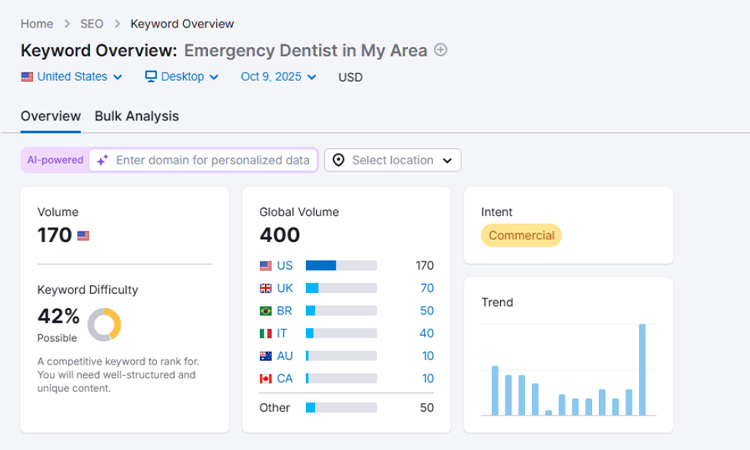
Let’s understand how to select the right keywords for your healthcare website.
How to Choose the Right Keywords?
While planning to write for healthcare SEO, always start with keywords because they will determine how easily patients will find the services. It is a very elaborate process, and at times it can seem very confusing. Let’s break down the whole process into easy steps so that you can understand it easily.
- Defining the Goal and Audience of Healthcare SEO: Begin by defining what you intend to achieve, like more telehealth bookings, more engagement, better visibility in local searches, or higher awareness about new services. Once you define the objective of your keywords, picture a few patient types, like a person searching for dental crowns or a sports person with a knee injury.
- Understanding the Search Intent: Every keyword has a story to tell. So, separate them into:
- Awareness: Patients learning about symptoms, for example, “Cause of Back Pain or Burning Sensation in Chest.”
- Consideration: Patients comparing options, for example, Best Physiotherapists in City.”
- Decision: Ready to book, example, ”Schedule Telehealth Counselling for Me.”
Matching content to these stages will guide patients naturally from research to decision.
- Gathering Real Patient Language: Look at the questions people usually ask while searching for healthcare online. And search terms in Google Search Console and “people also ask” results. These real phrases make the keyword list more accurate.
- Expand with Long Tail and Local Terms: Instead of going with broad search terms like “Dentist,” I use specific ones like “Emergency Dentist in My Area.” For more visibility, include conversational voice search phrases like, “Where can I get Same Day Dental Care Near Me?”
- Checking Keyword Potential: Search volume and booking intent competition of each keyword. Select the ones that bring qualified traffic, instead of chasing only high-volume search terms.
- Review competitors: Using tools like SEMrush or Ahrefs, see which keywords local competitors rank for and spot content gaps and fill them with better information.
- Map keywords to pages: Each keyword gets a place, like awareness keywords on blogs, decision keywords on booking or service pages. This keeps the site clear for both patients and search engines.
- Keep refining: Healthcare trends change, so monitor performance, update content, and adjust keywords every few months.
Example:
For a dental clinic in my area:
- “How to treat tooth sensitivity” will be incorporated in a blog post
- “Best dental clinic in Delhi” on the main service page
- “Book a dentist near me” for booking CTA
This step-by-step method keeps keyword strategy focused, patient-friendly, and effective at turning searches into appointments.
3. On-Page SEO for Healthcare Websites
On-page SEO fine-tunes your pages for better rankings and user experience.
Here are the main areas to focus on for Healthcare Websites:
- Optimising Title Tags and Meta Descriptions
- Title tags and meta descriptions are your website’s first impression on Google or other search engines. They are the short snippets that convince someone to click on your link instead of another.
- Keep titles short (around 60 characters) and naturally include your main keyword and location. For example, “Root Canal in Delhi| Dental Care Experts.”
- Meta descriptions should give a quick summary, sound friendly, and include a small call to action like” Book your consultation today.” These elements will all work together to improve your website’s visibility.
- Using Headings That Guide Readers: Headings are one of the important elements of content as they make your content easy to read and also help Google to understand your content.
Use one H1 tag for the main title and divide sections with H2s and H3s. For example:
- H1: “Telehealth Counselling Services in Brisbane”
- H2: “How Online Therapy Works”
- H3: “Why Patients Prefer Virtual Consultations”
A clear heading structure lets readers skim, find what they need quickly, and spend more time on your page.
- Making Content Clear and Easy to Read: Healthcare topics are complex for common people to understand, so simplicity is the key. Use short sentences, plain language instead of scientific jargon, and break information into bullet points to enhance readability. Always remember, clear communication builds trust with readers and also aligns with Google’s E-E-A-T standards (Experience, Expertise, Authoritativeness, and Trustworthiness).
- Link Pages Naturally: Internal links help both patients and search engines to navigate your website better. Link related pages together. For example, connect a blog on “Reasons of Gum Swelling” to your “Dental Care” service page. This keeps readers engaged longer and helps Google to understand your website’s structure better.
- Optimizing Images: Images make your content engaging for sure, but they can also slow down your website if not optimised. Use high-quality, compressed images with descriptive file names and alt text, such as “rool-canal-expert-new-delhi.jpg.” Alt text improves accessibility and also helps search engines know what the image is about.
- Using Clear Calls-to-Action (CTAs): Every page on your website should guide your patient to the next step. Whether booking an appointment, calling your clinic, or exploring more about a service. Use simple CTA like “Book Now”, “Call Us,” or “Schedule a Consultation.” Make them visible and easy to click.
When all these elements from the title to image optimization and CTA’s work together, your healthcare website becomes more than just another page on the internet. It turns into a patient-friendly space that feels helpful, trustworthy, and easy to use. In a nutshell, great on-page SEO is about creating a digital experience that builds both visibility and confidence.
4. Mobile SEO Deep Dive

Mobile optimization boosts user engagement, reduces bounce rates, and directly impacts your site’s SEO performance as Google always prioritizes mobile usability as a ranking factor. Here’s what to focus on-
- Mobile-First Indexing – Search engines use the mobile version of your healthcare site for indexing and ranking. So, your mobile site must load fast, show all content, and navigate easily.
- Accelerated Mobile Pages (AMP) – Implement AMP to deliver super-fast page loads on mobile, improve user experience, and potentially rankings.
- Voice and Conversational Search – Mobile patients use voice assistants more than desktop users. Optimize for natural, question-based queries like “Where can I get a flu shot near me?” or “Best pediatrician open on weekends.”
- Touch-Friendly Design – Buttons, forms, and navigation must be thumb-friendly. No pop-ups that frustrate mobile users.
- Local Mobile SEO – Since many mobile healthcare searches have local intent, ensure accurate location data and “near me” keyword targeting is prominent.
5. SEO for Telehealth Services
With telehealth booming post-pandemic, practices offering virtual consultations need a dedicated SEO approach-

- Telehealth Keywords – Include keywords like “online doctor consultation,” “virtual physiotherapy session,” “telehealth counselling in [location]” in your content, which are searched highly by people who need healthcare in your area.
- Dedicated Service Pages – Inform patients about telehealth services, technology requirements, appointment process, and privacy considerations.
- Local Telehealth SEO – Even virtual services benefit from local SEO by targeting residents in service areas with relevant keywords and Google Business Profile updates.
- Highlight the Benefits – Promote convenience, safety, and accessibility through blogs, testimonials, and videos.
- Mobile & Speed – Telehealth patients book or search last minute on mobile, so make sure mobile pages load fast.
Telehealth SEO captures a growing market segment and sets you apart as a modern and accessible healthcare provider.
6. Local SEO – Connect With Patients in Your Community
When people search for “best physiotherapist near me” or “24-hour clinic nearby,” they’re not just browsing; they are also looking for care right now. That is the step where local SEO steps in. Local SEO drives nearby patients to your clinic.
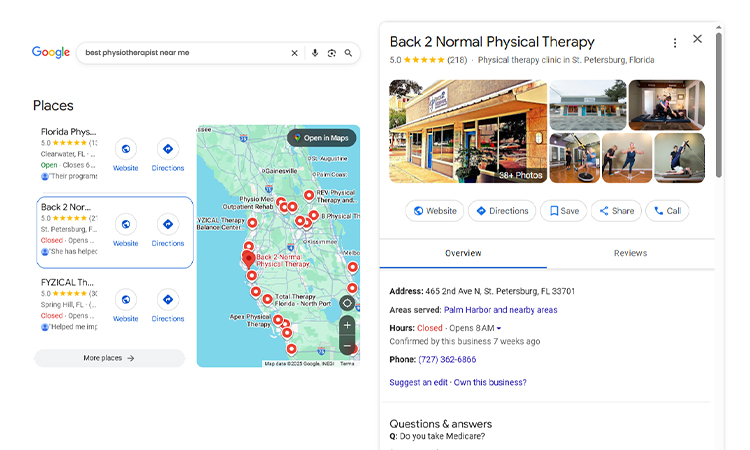
- Set Up and Optimize Your Google Business Profile – Your Google Business Profile is like your clinic’s digital front door. Keep it accurate and inviting. Include every detail, like your address, contact details, timings, website link, and service list in GMB. Add real photos of your clinic, doctors, and staff. Respond warmly to patient reviews to show you’re active and care about feedback.
- Use Location Specific Keywords – Think like your patients. They would not search “dentist.” They will type “best dentist near me” or “affordable root canal in Delhi.” Add such local keywords to your pages, blogs, and even image alt text. It helps Google and patients to understand where you are and what kind of treatment and services you offer.
- Keep Your Details Consistent Everywhere – Your Name, Address, and Phone number (NAP) should look the same on your website, directories, and social platforms. Even small differences like “Rd.” vs. “Road” can confuse search engines and patients alike.
- Engage With Your Community – Local SEO isn’t just digital. Write blogs about nearby health events, free check-up camps, or local health tips. Share updates about your clinic’s involvement in the community. It builds local credibility and positions you as a trusted neighbourhood expert.
When your clinic consistently shows up in local searches and on Google Maps, it doesn’t just improve visibility. It also builds familiarity and trust with the people who matter most: your community.
7. Technical SEO – Building a Website Patients and Search Engines Trust
Behind every smooth, professional healthcare website lies strong technical SEO. It’s the quiet force that keeps your site running fast, secure, and easy to find. The kind of experience both Google and patients appreciate.
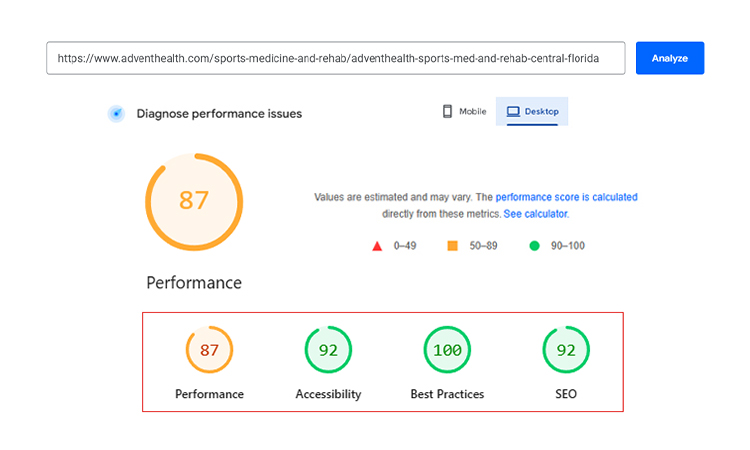
- Speed and Performance Matter – No one likes waiting, especially when searching for health information. As per a Google study 53% of visitors browsing a site through mobile will leave the page if it takes more than 3 seconds. So, ensure your pages load quickly by compressing images, using reliable hosting, and minimizing heavy scripts. A fast site keeps visitors engaged and improves rankings.
- Keep It Secure and Private – Healthcare sites deal with sensitive data. People will share their name, address, and past ailment history, etc. So, always use HTTPS and SSL certificates to protect patient information. This not only builds trust but is also a ranking factor for Google.
- Fix Broken Links and Errors Regularly – Nothing breaks trust faster than a “404 Page Not Found.” Run regular SEO audits to fix errors, redirects, or outdated links.
- Make It Accessible for Everyone – Follow accessibility standards (like WCAG) so that patients with visual or mobility impairments can easily use your website. Clear contrast, readable fonts, and voice-friendly design show inclusivity, and Google rewards that, too.
- Adding Schema Markup for Services and Doctors – Schema markup gives Google a detailed map of your practice. It helps a search engine to learn who you are, where you are located, services offered by you. For a healthcare website, use schema like Medical Organisation, Physician, or Local Business. These highlight your clinic name, visiting hours, address, and even doctor profiles right in search results. A proper schema will help your pages show rich details like star ratings or “Book an Appointment” links, making your listing stand out to potential patients.
Technical SEO isn’t just about pleasing algorithms. It’s about creating a safe, seamless, and trustworthy digital experience for your patients. One that reflects the care and professionalism of your practice itself.
8. Advanced Link Building Techniques
Link building is an SEO pillar. Beyond basic directory listings, advanced strategies include-

- Broken Link Building – Find broken links on authority health sites and offer your content as a replacement link.
- Resource Pages – List your site on resource pages of hospitals, universities, or non-profit health organizations for organic reach.
- Health Influencer Partnerships – Partner with health market professionals like health bloggers, patient advocates, or industry experts to create guest posts or social mentions.
- Social Proof – Make it a habit to share content on social media to get natural backlinks.
- Press Releases – Announce new services, awards, or community involvement to get media backlinks.
These methods improve site authority, referral traffic, and ranking potential.
9. Voice Search Optimisation
These days, people don’t even type. They will tap and ask Gemini or Siri and ask for nearby healthcare options. Voice search has become one of the preferred ways patients find healthcare services, especially on mobile devices and smart speakers. To leverage this trend fully-
- Natural Language Keywords – Voice searches are conversational and longer than typed queries. For example, “What are the symptoms of seasonal allergies?” instead of “seasonal allergy symptoms.”
- Featured Snippets & FAQ Pages – Having structured content to answer questions directly and clearly increases chances of being read out as voice search results. Detailed FAQ sections with patient-centric questions are highly effective.
- Local Optimisation – Voice searches often include questions like“ healthcare services near me” or location terms. So, make sure your local SEO is spot on with updated address and business hours.
- Conversational Content Tone – Write content like you are speaking directly to the patient, using “you” and easy language. It will help you connect with patients easily and create a trustworthy relationship.
Voice search optimization not only captures emerging patient queries but also improves overall site relevance and user experience.
10. AI and Automation for Healthcare SEO
AI is changing healthcare SEO, making it faster and more efficient—
- Keyword Research Automation – AI tools help to find trending keywords and long-tail queries in seconds, and also help you create content that drives organic traffic based on them.
- Content Creation – AI writing assistants can draft patient-friendly blogs, FAQs, and meta descriptions for you. They can also proofread and improve the readability of the content for you, doing hours of work in seconds.
- Chatbots – AI chatbots can engage patients instantly and also answer FAQs. They can also send reminders and help with appointment booking.
- Review Management – Automation tools can request reviews via SMS or email and track sentiment for insights. This helps in reputation management.
- Performance Monitoring – AI predicts SEO trends and recommends optimisation opportunities.
These AI SEO tools save time, improve accuracy, and enhance patient interaction on your site.
Conclusion
Healthcare SEO is no longer optional, but it’s mandatory. Patients are searching online, expecting fast, reliable, and local healthcare information. A patient-focused SEO strategy that follows Google’s E-E-A-T principles and compliance rules will get you higher rankings and truly connect with your community. From keyword research to local SEO to content marketing to technical excellence, every piece of your SEO puzzle matters. Always remember that when done properly and ethically, healthcare SEO helps you build a robust online presence, brings more patient bookings, and also helps to build trust-based relationships.
So, stay on top of trends with the right healthcare SEO strategies like voice search, telehealth optimisation, and AI-driven personalisation to succeed. Get professional SEO services for your healthcare practice today, because the patients who need care are already searching for you.

